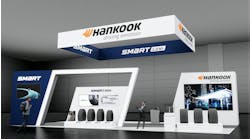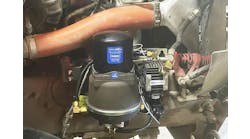For Howie Harding, vice president of sales for Service Tire Truck Centers (STTC), one of the benchmarks for success with a fleet is if he can reduce their annual tire purchases.
“If we do that, it means we’ve put together a comprehensive tire program that is reducing their costs, and they’ll need fewer replacement tires,” he said. “While that might mean fewer tire sales for STTC, our customers benefit from a reduced total cost of ownership. It will also showcase our value and commitment to them, and start a foundation for a long-lasting relationship.”
For larger fleets, the value a tire dealer brings coupled with expertise from the tire OEM go hand-in-hand in driving down costs. “That’s the special ingredient for fleets,” said Jason Miller, who heads Cooper Tire’s national account program. “If you have a tire dealer working with the national account rep from the tire OEM, you’re getting a very strong brain trust that can be invaluable. We work regularly with customers and dealers in understanding tire problems and coming up with solutions to make operations run better. Our national accounts team takes a vested interest in lowering costs for our customers—if we do that, we bring value to the table. And, ultimately, that’s what customers want.”
Overseeing sales at over 50 Service Tire locations in eight eastern states, Harding said large fleets are much better educated on tires than in the past. “It used to be fleets just wanted tires that had traction and the longest miles to removal,” he said. “They were less interested in retreadability, fuel economy, and data collection. But now that tires have become better engineered, all fleets, regardless of size, need to look at the whole picture and be open to new tires on the market that might advance their tire program.”
According to Harding, whenever a Service Tire rep visits a new fleet customer, they start asking questions long before tire brands are even discussed. “First and foremost, we have to learn about their operation, the equipment and routes they run. We want to understand their business. We then look at their equipment, check inflation levels and tire wear, see if they’re retreading, and what type of tires they’re running. Then we see if they have pain points or goals for their tire program. This could take place in one visit or it could take multiple days.”
“It’s somewhat similar to when a tire OEM national account rep visits a customer,” Miller said, adding fleets are typically eligible for national account service and pricing when they reach 50 power units. “We need to ask those same questions and then see if we have a tire that can match their requirements.”
At first glance, tires all look about the same from 10 feet away —round and black. “But, in reality, tires are a highly engineered product,” Miller said. “Manufacturers make decisions during R&D regarding which characteristics to emphasize in their design. Engineers start with a benchmark—how well the current products and/or competitive products perform on a specified set of criteria. They then set goals for what they want the new tire to be (based upon feedback from customers). Once developed and launched, reps know what the specific tire is engineered to do—and not do. Armed with this information, the rep helps match products to customers’ specific needs by walking the fleet, inspecting tires, and asking pointed questions.”
Miller likens finding the right tire for a fleet to online dating. “I often say each tire has a unique personality and each fleet has a unique personality,” he explained. “You learn from questions what each side wants and needs, then try to find matches with the greatest chance of success. But ultimately, you will never really know for sure until you go on a few dates. For us in the tire business, those ‘dates’ are products being tested within the fleet. That way we can see if we can out perform the incumbent tire, and if we do, then the next step is to place more tires in service to validate performance.”
Once a fleet has a structured tire program in place, Harding and Miller agree that on-going communication is required. “Tire programs can always improve,” Harding said. “For example, the tire dealer and tire OEM can do scrap tire analysis to help understand how tires are truly performing. It’s time consuming and costly for us, but it’s a big benefit for our customer. We can look at why tires were rejected for retreading, and what went wrong if a tire had to be replaced on a road call. A tire might have ‘failed’ at a retread facility because of age or number of retreads already undergone—or it may have exceeded the number of repairs the customer has set. That tells us the tire did its job. It can also show issues with flat spotting or other tire-wear issues that are mechanical, driver related, or misapplication. We’ve had customers who were improperly mounting their tires, causing bead issues. We identified the problem and educated their techs on the proper way for mounting and the problem went away.”
“Every tire tells a story,” Miller added. “Scrap tire analysis is one of the most underutilized tools a fleet can put to work. It will pay off in spades if they take the time. Dealers and OEM reps are often willing to work with customers to collect and analyze all the data.”
“Our ultimate goal as a tire dealer is to sell what’s behind the tire,” Harding said. “After the right tire is selected, it’s the services that we continue to provide that separates us from our competition. That’s what makes us different from other tire dealers. Service is our signature.”
Tips on building a tire program
Cooper’s Jason Miller, who’s been in the commercial tire business since 1995, offers up these tips on finding and working with a local tire rep, as well as a tire OEM rep, that can help turn around a fleet’s tire program.
Don’t keep chasing the “best deal” on tires
Many small fleets focus primarily on tire acquisition price. Some even buy in bulk quantities hoping the large order will motivate suppliers to sharpen their pencil. And this works to a small degree. Unfortunately, the so called, “best deal” tends to bounce from brand to brand depending on who has more surplus inventory or higher growth goals. This misses the greatest opportunities for cost savings.
Do your due diligence and test various products, document performance, cost per mile, fuel economy, and retreadability. When you add up the impact of those pieces of the total cost of ownership (TCO) puzzle, acquisition price has arguably the least profound impact on TCO. But it gets even better; most tire dealers will prioritize their loyal customers whenever a breakdown occurs. Think about it: If a dealer has seven service trucks and gets breakdown calls from seven loyal customers who depend on them and at the same time gets calls from five customers who only buy from them when they happen to have the lowest price, which customer do you suppose will get prioritized?
Find an experienced professional
I’ve been fortunate to have worked with literally hundreds of tire sales reps over the years. The few who come into it thinking, “How hard can it be?” quickly find out that selling commercial truck tires is harder than it looks. It’s a high stakes proposition where highly engineered products that all look about the same are used to address one of the trucking industry’s highest expenses. The good news is that reps that wake up each day just trying to “sell” something rarely last more than a year or so. Those who stick around are usually the ones who wake up every day looking to meet new fleet customers with tire related challenges that they can help solve.
Find someone with industry knowledge
The early days of a new tire rep’s career involve lots of cold calling. Eventually someone gives the rep an order and the fleet engagement begins. In the months and years that follow, the rep really gets to know the fleet and the challenges associated with that particular segment. Armed with this segment-specific knowledge, the rep then sets out to find similar fleets with similar issues that they can help solve. While much of this expertise is transferrable across a wide variety of applications, most reps tend to have one or two segments where they are particularly knowledgeable and effective. Work with a rep that knows your segment.
Find a tire “scientist”
Facts are friendly and the numbers don’t lie. What is the tire rep’s process for pulling costs out of a tire program? What kind of data do they provide and how frequently do they provide it? Does the data your tire rep gather include all tires that are scrapped? Wear comparisons? Yard checks? Purchase history?Tour the servicing provider’s facility
You can learn a lot about a service provider by taking a quick tour of their facility. Start by asking if you’ll need an appointment. Many dealers emphasize that they would rather have you arrive on a moment’s notice so you don’t wonder if they’ve spruced up the place for your visit. If possible, watch them dismount, mount, and install tires. Notice what kind of tools and lubes their techs use. Do they use a torque wrench on every install? Ask to see one of the service trucks and note if the tools and hoses are all in good working order.
For the retread plant, ask how they track their customer’s casings so they don’t get mixed up. Notice if the operation is clean with good lighting, especially in the final inspection area. For a complete list of retread plant tour considerations, you can reference TMC RP221E.
Don’t be afraid to ask for help
Ask your dealer to bring the manufacturer’s rep with them on a future visit. Walk your fleet with them and show them some of the problems you’re experiencing. Ask for their input. Each of these folks visit 20 to 100 different fleets every month; there’s a good chance that whatever issue you’re having is something they’ve seen before.
Ask about emergency tire service
If you travel interstate, how will the tire dealer or tire OEM (if you’re a national account) help you with a tire issue on the road—especially in the middle of the night. What is the tire dealer’s acceptance rate for road calls? What is the typical “call-to-roll” time?
Ask potential suppliers for fleet references
If you’re looking to change tire brands and work with a new tire dealer, it’s a good idea to ask for fleet references. Ask the fleet the following:
- How long have you been using the tire dealer and specific brand of tire?
- Who else have you tried? Why did you switch?
- How long is their retread turnaround time?
- How do they guarantee you get back your own casings?
- Do they provide any “value-added” services such as fleet yard checks, RAR/NRT reporting, or tire performance monitoring?
Become a member of TMC
You can rely on a tire rep to help you with your tire program, but if you can take an active part and become educated yourself, all the better. I strongly recommend joining the American Trucking Associations’ Technology and Maintenance Council (TMC). This can help you become better educated on tire issues and solutions from other top fleets throughout the country. These are like-minded individuals who work tirelessly to solve many of the same problems that every fleet has faced or may someday have to face.
Engage all stakeholders
Get your drivers and maintenance staff educated on tires. Even the best tires and the best service can’t overcome a lack of pre-trip inspections, careless and aggressive driving, and haphazard routine maintenance.
Don’t be complacent—seek continuous improvement
Don’t be afraid to test tires. When you do, take it seriously and work with your tire rep (either from your tire dealer or through the tire OEM rep) to document performance. That means regular measurements for wear and constant checks on air pressure and vehicle condition.





